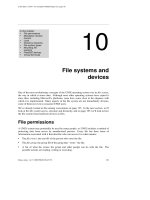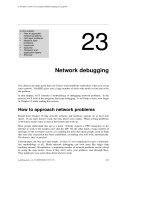Chapter 10: Packet Switching doc
Bạn đang xem bản rút gọn của tài liệu. Xem và tải ngay bản đầy đủ của tài liệu tại đây (397.05 KB, 50 trang )
William Stallings
Data and Computer
Communications
Chapter 10
Packet Switching
Principles
Circuit switching designed for voice
Resources dedicated to a particular call
Much of the time a data connection is idle
Data rate is fixed
Both ends must operate at the same rate
Basic Operation
Data transmitted in small packets
Typically 1000 octets
Longer messages split into series of packets
Each packet contains a portion of user data plus
some control info
Control info
Routing (addressing) info
Packets are received, stored briefly (buffered)
and past on to the next node
Store and forward
Use of Packets
Advantages
Line efficiency
Single node to node link can be shared by many
packets over time
Packets queued and transmitted as fast as possible
Data rate conversion
Each station connects to the local node at its own
speed
Nodes buffer data if required to equalize rates
Packets are accepted even when network is
busy
Delivery may slow down
Priorities can be used
Switching Technique
Station breaks long message into packets
Packets sent one at a time to the network
Packets handled in two ways
Datagram
Virtual circuit
Datagram
Each packet treated independently
Packets can take any practical route
Packets may arrive out of order
Packets may go missing
Up to receiver to re-order packets and recover
from missing packets
Virtual Circuit
Preplanned route established before any packets
sent
Call request and call accept packets establish
connection (handshake)
Each packet contains a virtual circuit identifier
instead of destination address
No routing decisions required for each packet
Clear request to drop circuit
Not a dedicated path
Virtual Circuits v Datagram
Virtual circuits
Network can provide sequencing and error control
Packets are forwarded more quickly
No routing decisions to make
Less reliable
Loss of a node looses all circuits through that node
Datagram
No call setup phase
Better if few packets
More flexible
Routing can be used to avoid congested parts of the
network
Packet Size
Circuit v Packet Switching
Performance
Propagation delay
Transmission time
Node delay
Event Timing
External and Internal Operation
Packet switching - datagrams or virtual circuits
Interface between station and network node
Connection oriented
Station requests logical connection (virtual circuit)
All packets identified as belonging to that connection &
sequentially numbered
Network delivers packets in sequence
External virtual circuit service
e.g. X.25
Different from internal virtual circuit operation
Connectionless
Packets handled independently
External datagram service
Different from internal datagram operation
Combinations (1)
External virtual circuit, internal virtual circuit
Dedicated route through network
External virtual circuit, internal datagram
Network handles each packet separately
Different packets for the same external virtual circuit
may take different internal routes
Network buffers at destination node for re-ordering
Combinations (2)
External datagram, internal datagram
Packets treated independently by both network and
user
External datagram, internal virtual circuit
External user does not see any connections
External user sends one packet at a time
Network sets up logical connections
External
Virtual
Circuit and
Datagram
Operation
Internal
Virtual
Circuit and
Datagram
Operation
Routing
Complex, crucial aspect of packet switched
networks
Characteristics required
Correctness
Simplicity
Robustness
Stability
Fairness
Optimality
Efficiency
Performance Criteria
Used for selection of route
Minimum hop
Least cost
See Stallings appendix 10A for routing algorithms
Costing of Routes
Decision Time and Place
Time
Packet or virtual circuit basis
Place
Distributed
Made by each node
Centralized
Source
Network Information Source
and Update Timing
Routing decisions usually based on knowledge of
network (not always)
Distributed routing
Nodes use local knowledge
May collect info from adjacent nodes
May collect info from all nodes on a potential route
Central routing
Collect info from all nodes
Update timing
When is network info held by nodes updated
Fixed - never updated
Adaptive - regular updates
Routing Strategies
Fixed
Flooding
Random
Adaptive
Fixed Routing
Single permanent route for each source to
destination pair
Determine routes using a least cost algorithm
(appendix 10A)
Route fixed, at least until a change in network
topology
Fixed Routing
Tables









